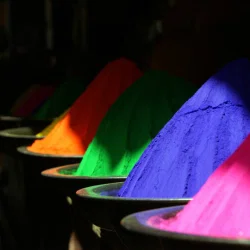Here are key features and aspects of pearlescent pigments
2023-12-12
Pearlescent pigments, also known as pearl pigments or interference pigments, are special types of pigments that create a shimmering or iridescent effect on surfaces. They are often used in a variety of applications, including cosmetics, automotive coatings, plastics, printing inks, and industrial coatings. Here are key features and aspects of pearlescent pigments:
1. Composition:
- Pearlescent pigments are typically composed of a base material, such as mica or synthetic mica, coated with metal oxides or other materials. The coating creates interference effects that produce the pearlescent or iridescent appearance.
2. Interference Effect:
- The unique optical effect of pearlescent pigments is due to interference between light waves reflected from the surface of the pigment and the light waves that pass through the transparent coating. This interference leads to the perception of various colors depending on the viewing angle.
3. Iridescent Colors:
- Pearlescent pigments can produce a range of iridescent colors, often resembling the shimmering effect seen on the surface of pearls. Common colors include shades of white, silver, gold, and a variety of pastel hues.
4. Particle Size:
- The particle size of pearlescent pigments plays a crucial role in determining the final appearance. Finer particles tend to produce a more subtle effect, while larger particles can create a more pronounced and glittering appearance.
5. Applications in Cosmetics:
- Pearlescent pigments are widely used in cosmetics, including eyeshadows, lipsticks, nail polishes, and other beauty products. They add a lustrous and visually appealing quality to cosmetic formulations.
6. Automotive Coatings:
- In the automotive industry, pearlescent pigments are used in automotive coatings to create special effects on cars and motorcycles. They can be applied in basecoats or clearcoats to achieve unique and eye-catching finishes.
7. Plastics and Polymers:
- Pearlescent pigments are incorporated into plastics and polymers to enhance their appearance. They are commonly used in the production of toys, packaging materials, and various molded plastic products.
8. Printing Inks:
- Printing inks, particularly those used in packaging and publications, may contain pearlescent pigments to impart a visually striking quality to printed materials.
9. Industrial Coatings:
- Pearlescent pigments find applications in industrial coatings for products such as appliances, furniture, and metal surfaces. The effect adds a touch of elegance and sophistication to coated surfaces.
10. Art and Craft Supplies:
- Pearlescent pigments are used in art and craft supplies, including paints, inks, and powders. Artists and crafters often appreciate the unique visual effects these pigments can bring to their creations.
11. Ceramics and Glass:
- In the ceramics and glass industry, pearlescent pigments are employed to create decorative effects on pottery, glassware, and tiles.
12. Packaging and Branding:
- Pearlescent pigments are utilized in packaging materials to enhance the visual appeal of labels, boxes, and other branded materials.
13. Light-Diffusing Applications:
- In addition to their color-shifting properties, pearlescent pigments are sometimes used for their light-diffusing characteristics, making them suitable for applications where light scattering is desirable.
The versatile and visually appealing nature of pearlescent pigments makes them a popular choice in various industries where creating a distinctive and captivating appearance is important. The choice of pigment depends on the specific application and the desired visual effect.



